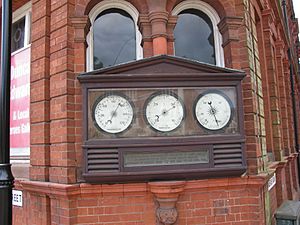Dudley Museum and Art Gallery facts for kids
The Dudley Museum and Art Gallery was a cool place in Dudley, England, where you could explore history and art. It first opened its doors in 1883 on St James's Road. This museum was a popular spot for many years until it closed in 2016. Don't worry, though! Some of its amazing collections have moved to the Dudley Archives centre on Tipton Road, so you can still see them.

Meteorological instrument display on the corner of the former Dudley Museum. The dedication plaque has since been removed due to vandalism.
|
|
| Lua error in Module:Location_map at line 420: attempt to index field 'wikibase' (a nil value). | |
| Established | 3 July 1883 |
|---|---|
| Dissolved | 22 December 2016 |
| Location | Dudley, West Midlands |
| Type | Natural history and local interest |
Contents
A Look Back at the Museum's History
The building that became the museum was first planned as a Free Library and an Art School. The very first stone was laid on July 3, 1883, by a local leader named Earl Beauchamp. Even though an art gallery was part of the plan, it took five more years to open. The gallery officially welcomed visitors on August 1, 1888.
In 1906, the Dudley Council decided to take over a collection of fossils and other cool stuff from the Dudley Geographical Society. They wanted to show these items in a museum. By 1911, this collection was ready to be displayed to the public in 1912.
Why the Museum Closed
The Dudley Museum and Art Gallery closed its doors on December 22, 2016. This happened because the local council needed to save money. But the story doesn't end there!
Many of the museum's collections found a new home at the Dudley Archives centre on Tipton Road. This new place, called 'Dudley Museum at The Archives', opened in September 2017. It's also the main office for the Black Country Geopark project. This project hopes to get special recognition from UNESCO for the area's amazing geological history.
Awesome Things to See
The Dudley Museum had many exciting exhibits. Here are some of the most popular ones:
Discovering Local Geology
The museum's geology exhibits were super important. They featured about 15,000 fossils found right in the local area, including places like Wren's Nest hill. These exhibits helped visitors learn about the Earth's past.
Dudley Unearthed: A Journey Through Time
The 'Dudley Unearthed' area showed how the local geology connected to the Industrial Revolution. It had changing displays about the geology of the area and the world. You could even learn about the Dudley Volcano! Fossils from this volcano, which erupted about 315 million years ago, were also on display.
Fantastic Fossils: Ancient Life Forms
The 'Fantastic Fossils' exhibit was a highlight. It displayed fossils from the Silurian and Carboniferous periods. You could see fossilized corals, seashells, Crinoids (sea lilies), Gastropods (snails), Trilobites (ancient sea creatures), and even ancient plants.
Return of the Dinosaurs
This exhibit opened in 2007 and was a big hit! It featured large models of different dinosaur species. Imagine seeing a huge Baryonyx or one of the earliest dinosaurs, the Thecodontosaurus! It was like stepping back into prehistoric times.
The Brooke Robinson Collection
In 1911, a local politician named Brooke Robinson left his amazing collection to Dudley. This included paintings, furniture, ceramics, and medals. These items were displayed in a special room at the museum. You could see British and European art from the 17th, 18th, and 19th centuries. There were also cool Japanese items like netsuke and inro, and ancient Greek, Roman, and Egyptian pottery.
Celebrating Local Heroes
This room was dedicated to local heroes, especially football legend Duncan Edwards. He was born in Dudley in 1936 and was a famous player for Manchester United. Duncan was part of the "Busby Babes" team and played for England 18 times. Sadly, he died at just 21 years old in the Munich air disaster in 1958. The exhibit showed many items connected to his life and career.
The Fine Art Collection
The museum also had a large collection of fine art. This included oil paintings, watercolours, and prints. These artworks were regularly changed so visitors could see different pieces. Works by local artist Percy Shakespeare were often featured.

